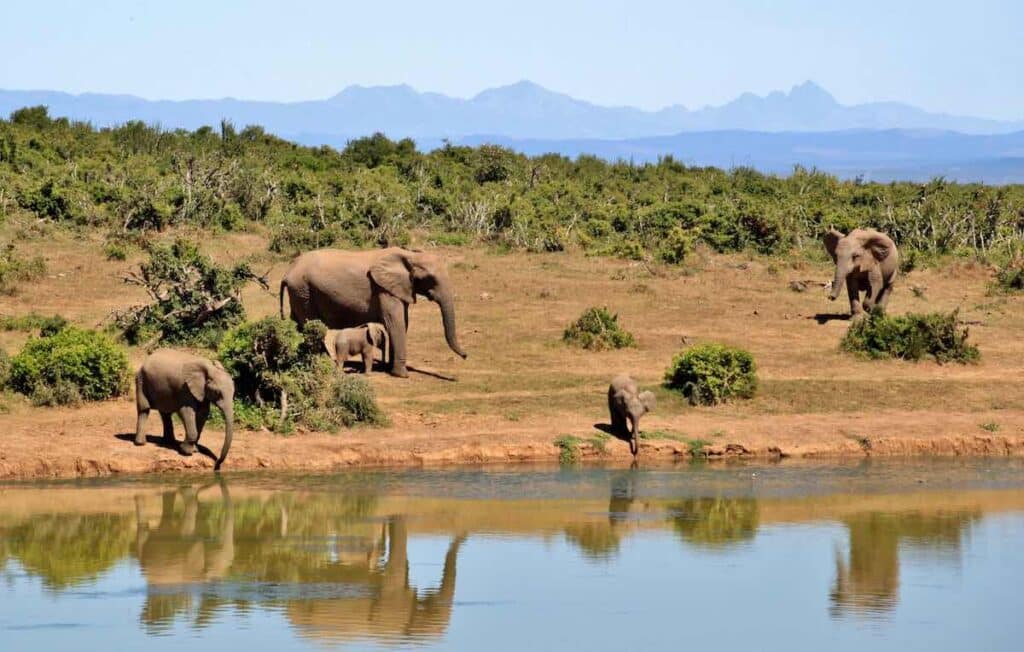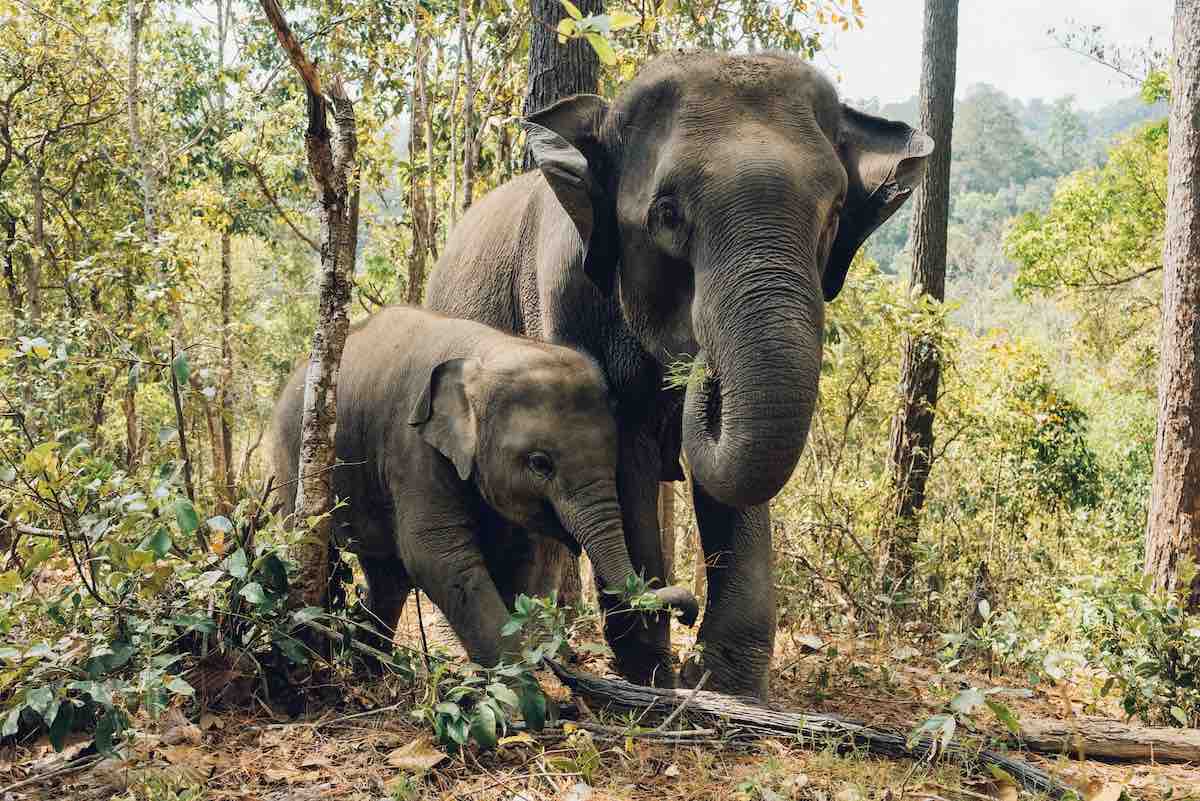Welcome to our exploration of the signs of elephant presence in nature and the wild! Elephants are majestic creatures that have captured the imagination of people around the world for centuries.
Their sheer size, intelligence, and complex social behavior make them one of the most fascinating animals on the planet.
In this article, we will take a closer look at the ways in which elephants leave their mark on the natural world and how to recognize the signs of their presence in their natural habitats.
If you’re looking to track elephants, you should be on the lookout for footprints, droppings, dung piles, and broken branches.
Whether you are an avid wildlife enthusiast or simply interested in learning more about how to spot these incredible animals in the wild, this article is sure to provide you with new learnings that you can put into practise on your next trip.
So let’s dive in and discover the many signs of elephants in nature!
11 Signs Of Elephants In The Wild
Elephants are some of the most exciting animals in the world, leaving behind many signs that they have been in, or occupy an area.

Here are some of the most obvious ways to know if there are elephants within a close proximity:
1. Elephant Tracks & Footprints
One of the most apparent signs of elephants in an area is the presence of their tracks. Elephants leave a colossal imprint on the terrain as they traverse through lush forests or sprawling savannas, with their footprints measuring up to 30 centimeters deep!
Bull elephant tracks are large and round, with a distinct pattern. Although invisible to the naked eye, the elephant’s front foot has five hooves and its hind foot has four.
Additionally, their tracks often lack a visible heel area – creating an almost smooth look. If you see ways that match this description, elephants are likely in the area.
2. Droppings and Dung
Elephant droppings are one of the most telling signs that there is an elephant nearby. A single elephant can produce large amounts of dung, which is typically round and chunky in shape, and has a distinct, earthy smell.
The size and frequency of the droppings can also indicate the age and health of the elephant, as well as their diet and feeding habits.
Elephant dung can often be found in piles near water sources or areas where elephants have been feeding.
3. Damaged Trees
Elephants are large animals that can cause significant damage to trees. Elephants have likely been in the area if you see trees snapped in half or uprooted.
Additionally, elephants are expected to be on the site if you see trees with significant bark scratches or rub marks.
The scratches are formed when elephants use the tree to scratch and rub against, especially on young trees with softer bark.
4. Vocalizations & Trumpeting
Elephants have an impressive range of vocalizations that can be heard from afar. If you hear any loud trumpeting, rumbling sounds or bellows then there’s a good chance that elephants are nearby!
You may also hear a low-pitched noise resembling a thundering roar in the distance. This is typically the sound of an elephant herd communicating with each other, or announcing its presence in an area.
5. Wallowing Pools
Elephants are fond of water and like to keep cool by rolling in mud and mud pools.
If you come across a muddy pool with large, circular depressions then it’s likely an elephant has been there recently.
6. Elephant Trails
Elephants often use trails to travel from one place to another, which makes them easier to track than other animals that wander aimlessly around the landscape.
Look out for long, straight paths with packed-down earth and broken branches – these are likely made by elephants as they normally travel in large herds.
7. Bait digging
Elephants dig for food using their tusks, which leaves behind visible signs on the ground.
Look out for holes that are around two feet deep and in the shape of a U, as well as scattered piles of dirt.
8. Broken branches
In addition to damaging trees, elephants can also break components off trees. You have likely been in the area if you see broken limbs and branches on the ground.
Elephants will break branches off trees to eat the leaves and fruit, or use them for other purposes such as scratching themselves.
9. Rustling
Rustling is like trumpeting, it’s hard to miss. Obviously, with plenty of wild animals roaming the same places as elephants, it can be hard to tell whether the rustling is from elephants or something else.
But if you’re in an area with plenty of vegetation and other foliage, chances are, it’s probably coming from an elephant.
Plus, because of their size, elephants can easily and often cause a disturbance in the surrounding foliage.
10. Elephant Habitat
The best way to spot elephants is by observing their habitat. Elephants are typically found in areas with plenty of vegetation, water sources, and mud wallows.
Open savannas and wooded grasslands are also common habitats for elephants.
There’s a difference here between the habitats of African and Asian elephants, with African elephants typically living in open grasslands, and Asian elephants more adapted to dense forests and jungles.
11. Social behaviors
Elephants are social animals and they live in closely knit family groups of related individuals. If you observe a large group of elephants, it’s likely that you’re seeing a family unit or herd.
You may also be able to spot behaviors such as baby elephants playing with their mothers, adults caring for their young, and even males displaying dominance by mock-charging.
Be aware that one elephant very seldom travels alone, so if you spot one elephant then there are likely more in the area.

How To Identify The Signs Of Elephants In The Wild From A Distance?
Identifying elephants from a distance can be a fun and rewarding experience! To start, you should look out for their unique silhouette.
Elephants are the largest land mammal and have incredibly long trunks, so they easily stand out. You may see them fanning their ears or flapping their chest while they feed or march across the savanna.
Another telltale sign of an elephant family is discovering the distinctive rolling walk they have thanks to their widely-separated feet and columnar legs.
The easiest way to spot an elephant from a distance is by looking out for their unique tracks. Elephants leave behind large footprints that are easy to spot in mud, sand, and soil.
Finally, you may hear the distinctive sound of elephant calls echoing across the plains. Elephants communicate with each other using low frequency rumbles and trumpets that can travel over long distances.
The Role of Conservation in Protecting the Wild Elephant Population
Wild elephants are amazing animals whose populations must remain healthy and protected. Conservation is decisive in safeguarding these herds from poaching, illegal logging, and other threats.
Non-profit organizations engage in various initiatives to protect elephant habitats from destruction, from patrolling the forests to ensuring compliance with conservation regulations.
Educating local communities about the importance of wildlife conservation makes it possible to create a safe and secure elephant sanctuary for these beloved animals.
Recommended reading: How Many Elephants are Left in the World? →
Final Thoughts On Signs Of Elephants In The Wild
Elephants are fascinating animals, and it’s possible to tell if they’re in the area by looking out for certain signs. Elephant tracks and footprints are one of the most apparent signs, with bull elephant tracks being large and round with a distinct pattern.
Another tell-tale sign is the presence of elephant droppings, which are typically round and chunky in shape and can indicate the age and health of the elephant, as well as their diet and feeding habits.
Damaged trees, vocalizations and trumpeting, wallowing pools, elephant trails, bait digging, broken branches, rustling, elephant habitat, and social behaviors are all signs to look out for when trying to determine if there are elephants in the area.
By keeping an eye out for these signs, you might be able to catch a glimpse of these magnificent creatures in their natural habitat.
While these signs can indicate the presence of elephants in the wild, it’s important to note that some of these signs can be caused by other animals or natural processes.
For example, damaged trees or broken branches can be caused by storms or other animals, and vocalizations can sometimes be heard from other species.
Additionally, some of these signs may not be present in all areas where elephants live. For example, in areas where elephants have been heavily hunted or disturbed by humans, they may be less likely to leave behind tracks or other signs of their presence.
Finally, it’s also important to approach wild elephants with caution and respect. While these animals are fascinating to observe, they can be dangerous if provoked or surprised.
It’s best to observe elephants from a safe distance and never to approach them directly on foot or in a vehicle.
Frequently Asked Questions About Signs Of Elephants In The Wild
The most common sign that there are elephants close by is tracks, dung, damaged trees, broken branches, and crushed vegetation.
Experts track elephants in the wild by looking for signs such as tracks, dung, and broken branches. They also use cameras traps to monitor animal movements and behavior. Additionally, they will look for areas with plenty of vegetation, water sources, and mud wallows that are indicative of elephant habitat.
When spotting an elephant, you should look out for their unique silhouette and long trunk. Additionally, they often fan their ears or flap their chest while they feed or march across the savanna. You should also be able to spot them by their distinctive rolling walk due to their widely-separated feet and columnar legs.
Yes, elephant habitat is typically found in tropical and subtropical forests and grasslands. African elephants are more likely to be found in savannas while Asian elephants prefer lowland rainforests or dry deciduous forests.
The biggest danger when tracking elephants is getting too close and startling them, as this can cause them to become aggressive. It’s important to remain at a safe distance and not disrupt their natural behavior. Additionally, it’s important to be aware of the local laws and regulations regarding elephant conservation and safety.
